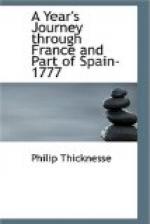Cardinal Richlieu, I am assured, had several consultations with builders of eminence, and architects of genius, to consider whether it was practicable to remove all the parts of this edifice, and re-erect it at Versailles: and, I have no doubt, but Lewis the 14th might have raised this monument to his fame there, for half the money he expended in murdering and driving out of that province sixty thousand of his faithful and ingenious subjects, merely on the score of Religion; an act, which is now equally abhorred by Catholics, as well as Protestants. But, Lord Chesterfield justly observes, that there is no brute so fierce, no criminal so guilty, as the creature called a Sovereign, whether King, Sultan, or Sophy; who thinks himself, either by divine or human right, vested with absolute power of destroying his fellow-creatures.
Louis the XIth of France caused the Duke of Nemours, a descendant of King Clovis, to be executed at Paris, and placed his children under the scaffold, that the blood of their father might run upon their heads; in which bloody condition they were returned to the Bastile, and there shut up in iron cages: and a King of SIAM, having lost his daughter, and fancying she was poisoned, put most of his court, young and old, to death, by the most exquisite torture; by this horrid act of cruelty, near two thousand of the principal courtiers suffered the most dreadful deaths; the great Mandarins, their wives, and children, being all scorched with fire, and mangled with knives, before they were admitted to his last favour,—that of being thrown to the elephants.
But to have done with sad subjects.—It was not till the year 1758 that it was certainly known at what time, or for what purpose, the Maison Carree was erected; but fortunately, the same town which produced the building so many ages ago, produced in the latter end of the last, a Gentleman, of whom it may be justly said, he left no stone unturned to come at the truth. This is Mons. Seguier, whose long life has been employed in collecting a cabinet of Roman antiquities, and natural curiosities, and whose penetrating genius alone could have discovered, by the means he did, an inscription, of which not a single letter has been seen for many ages; but this habile observateur, perceiving a great number of irregular holes upon the frontal and frize of this edifice, concluded that they were the cramp-holes which had formerly held an inscription, and which, according to the practice of the Romans, were often composed of single letters of bronze. Mons. Seguier therefore erected scaffolding, and took off on paper the distances and situation of the several holes, and after nicely examining the disposition of them, and being assisted by a few faint traces of some of the letters, which had been impressed on the stones, brought forth, to the full satisfaction of every body, the original inscription, which was laid before l’Academie des Inscriptions & de Belles Lettres de Paris of which he is a member, and from whom he received their public thanks; having unanimously agreed that there was not a doubt remained but that he had produced the true reading: which is as follows:




